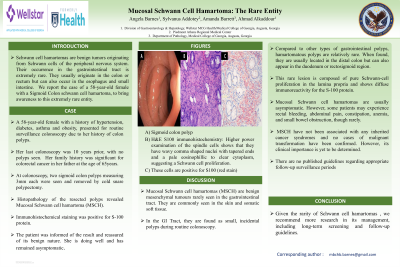Sunday Poster Session
Category: Colon
P0334 - Mucosal Schwann Cell Hamartoma: The Rare Entity
Sunday, October 27, 2024
3:30 PM - 7:00 PM ET
Location: Exhibit Hall E

Has Audio
- AB
Angela Barnes, MD, MBChB
Medical College of Georgia at Augusta University
Augusta, GA
Presenting Author(s)
Angela Barnes, MD, MBChB1, Sylvanus Addotey, MBChB2, Amanda Barrett, MD3, Ahmad Alkaddour, MD1
1Medical College of Georgia at Augusta University, Augusta, GA; 2Piedmont Athens Regional, Arthens, GA; 3Augusta University, Augusta, GA
Introduction: Schwann cell hamartomas are benign tumors originating from Schwann cells of the peripheral nervous system. Their occurrence in the gastrointestinal tract is extremely rare. They usually originate in the colon or rectum but can also occur in the esophagus and small intestine. We report the case of a 58-year-old female with a Sigmoid Colon schwann cell hamartoma, to bring awareness to this extremely rare entity.
Case Description/Methods: A 58 year-old female with a history of hypertension, diabetes, asthma and obesity, presented for routine surveillance colonoscopy due to her history of colon polyps. Her last colonoscopy was 10 years prior, with no polyps seen. Her family history was significant for colorectal cancer in her father at the age of 65years. At colonoscopy, two sigmoid colon polyps measuring 3mm each were seen and removed by cold snare polypectomy. Histopathology of the resected polyps revealed Mucosal Schwann cell hamartoma (MSCH). Immunohistochemical staining was positive for S-100 protein. The patient was informed of the result and reassured of its benign nature. She is doing well and has remained asymptomatic.
Discussion: Mucosal Schwann cell hamartomas (MSCH) are benign mesenchymal tumours rarely seen in the gastrointestinal tract. They are commonly seen in the skin and somatic soft tissue. In the GI Tract, they are found as small, incidental polyps during routine colonoscopy. Compared to other types of gastrointestinal polyps, hamartomatous polyps are relatively rare. When found, they are usually located in the distal colon, but can also appear in the duodenum or rectosigmoid region. This rare lesion is composed of pure Schwann-cell proliferation in the lamina propria and shows diffuse immunoreactivity for the S-100 protein.
Mucosal Schwann cell hamartomas are usually asymptomatic. However, some patients may experience rectal bleeding, abdominal pain, constipation, anemia, and small bowel obstruction, though rarely. MSCH have not been associated with any inherited cancer syndromes and no cases of malignant transformation have been confirmed. However, its clinical importance is yet to be determined. There are no published guidelines regarding appropriate follow-up surveillance periods. Given the rarity of this condition, we recommend more research in its management, including long-term screening and follow-up guidelines.

Disclosures:
Angela Barnes, MD, MBChB1, Sylvanus Addotey, MBChB2, Amanda Barrett, MD3, Ahmad Alkaddour, MD1. P0334 - Mucosal Schwann Cell Hamartoma: The Rare Entity, ACG 2024 Annual Scientific Meeting Abstracts. Philadelphia, PA: American College of Gastroenterology.
1Medical College of Georgia at Augusta University, Augusta, GA; 2Piedmont Athens Regional, Arthens, GA; 3Augusta University, Augusta, GA
Introduction: Schwann cell hamartomas are benign tumors originating from Schwann cells of the peripheral nervous system. Their occurrence in the gastrointestinal tract is extremely rare. They usually originate in the colon or rectum but can also occur in the esophagus and small intestine. We report the case of a 58-year-old female with a Sigmoid Colon schwann cell hamartoma, to bring awareness to this extremely rare entity.
Case Description/Methods: A 58 year-old female with a history of hypertension, diabetes, asthma and obesity, presented for routine surveillance colonoscopy due to her history of colon polyps. Her last colonoscopy was 10 years prior, with no polyps seen. Her family history was significant for colorectal cancer in her father at the age of 65years. At colonoscopy, two sigmoid colon polyps measuring 3mm each were seen and removed by cold snare polypectomy. Histopathology of the resected polyps revealed Mucosal Schwann cell hamartoma (MSCH). Immunohistochemical staining was positive for S-100 protein. The patient was informed of the result and reassured of its benign nature. She is doing well and has remained asymptomatic.
Discussion: Mucosal Schwann cell hamartomas (MSCH) are benign mesenchymal tumours rarely seen in the gastrointestinal tract. They are commonly seen in the skin and somatic soft tissue. In the GI Tract, they are found as small, incidental polyps during routine colonoscopy. Compared to other types of gastrointestinal polyps, hamartomatous polyps are relatively rare. When found, they are usually located in the distal colon, but can also appear in the duodenum or rectosigmoid region. This rare lesion is composed of pure Schwann-cell proliferation in the lamina propria and shows diffuse immunoreactivity for the S-100 protein.
Mucosal Schwann cell hamartomas are usually asymptomatic. However, some patients may experience rectal bleeding, abdominal pain, constipation, anemia, and small bowel obstruction, though rarely. MSCH have not been associated with any inherited cancer syndromes and no cases of malignant transformation have been confirmed. However, its clinical importance is yet to be determined. There are no published guidelines regarding appropriate follow-up surveillance periods. Given the rarity of this condition, we recommend more research in its management, including long-term screening and follow-up guidelines.

Figure: A) Sigmoid colon polyp
B) H&E S100 immunohistochemistry: Higher power examination of the spindle cells shows that they have wavy comma shaped nuclei with tapered ends and a pale eosinophillic to clear cytoplasm, suggesting a Schwann cell proliferation.
C) These cells are positive for S100 (red stain)
B) H&E S100 immunohistochemistry: Higher power examination of the spindle cells shows that they have wavy comma shaped nuclei with tapered ends and a pale eosinophillic to clear cytoplasm, suggesting a Schwann cell proliferation.
C) These cells are positive for S100 (red stain)
Disclosures:
Angela Barnes indicated no relevant financial relationships.
Sylvanus Addotey indicated no relevant financial relationships.
Amanda Barrett indicated no relevant financial relationships.
Ahmad Alkaddour indicated no relevant financial relationships.
Angela Barnes, MD, MBChB1, Sylvanus Addotey, MBChB2, Amanda Barrett, MD3, Ahmad Alkaddour, MD1. P0334 - Mucosal Schwann Cell Hamartoma: The Rare Entity, ACG 2024 Annual Scientific Meeting Abstracts. Philadelphia, PA: American College of Gastroenterology.
